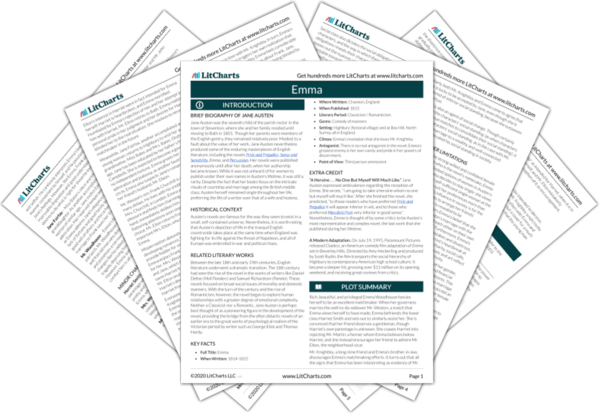Welcome to the LitCharts study guide on Jane Austen's Emma. Created by the original team behind SparkNotes, LitCharts are the world's best literature guides.
Emma: Introduction
Emma: Plot Summary
Emma: Detailed Summary & Analysis
Emma: Themes
Emma: Quotes
Emma: Characters
Emma: Symbols
Emma: Literary Devices
Emma: Quizzes
Emma: Theme Wheel
Brief Biography of Jane Austen

Historical Context of Emma
Other Books Related to Emma
- Full Title: Emma
- When Written: 1814-1815
- Where Written: Chawton, England
- When Published: 1815
- Literary Period: Classicism / Romanticism
- Genre: Comedy of manners
- Setting: Highbury (fictional village) and at Box Hill, North Surrey, all in England.
- Climax: Emma’s revelation that she loves Mr. Knightley
- Antagonist: There is no real antagonist in the novel; Emma’s greatest enemy is her own vanity and pride in her powers of discernment.
- Point of View: Third person omniscient
Extra Credit for Emma
“A Heroine . . . No One But Myself Will Much Like.” Jane Austen expressed ambivalence regarding the reception of Emma. She wrote, “I am going to take a heroine whom no one but myself will much like.” After she finished the novel, she predicted, “to those readers who have preferred Pride and Prejudice it will appear inferior in wit, and to those who preferred Mansfield Park very inferior in good sense.” Nonetheless, Emma is thought of by some critics to be Austen’s most representative and complex novel, the last work that she published during her lifetime.
A Modern Adaptation. On July 19, 1995, Paramount Pictures released Clueless, an American comedy film adaptation of Emma set in Beverley Hills. Directed by Amy Heckerling and produced by Scott Rudin, the film transports the social hierarchy of Highbury to contemporary American high school culture. It became a sleeper hit, grossing over $11 million on its opening weekend, and receiving great reviews from critics.












